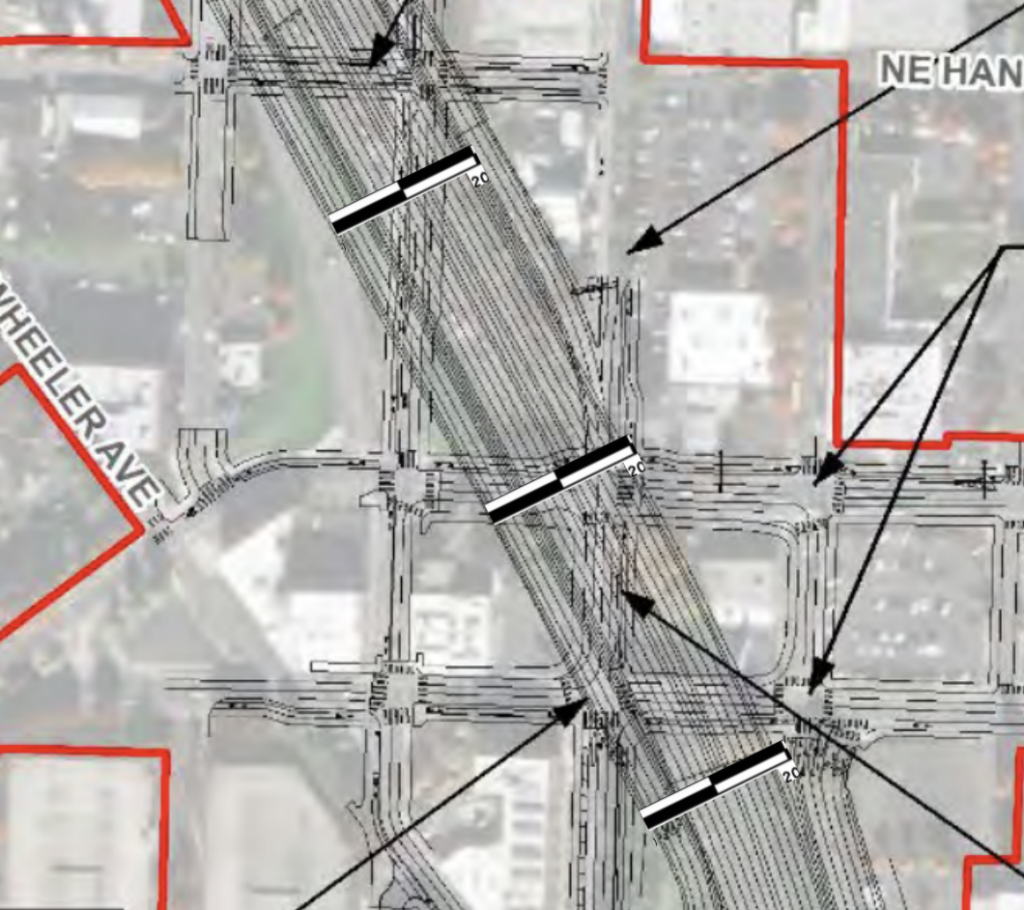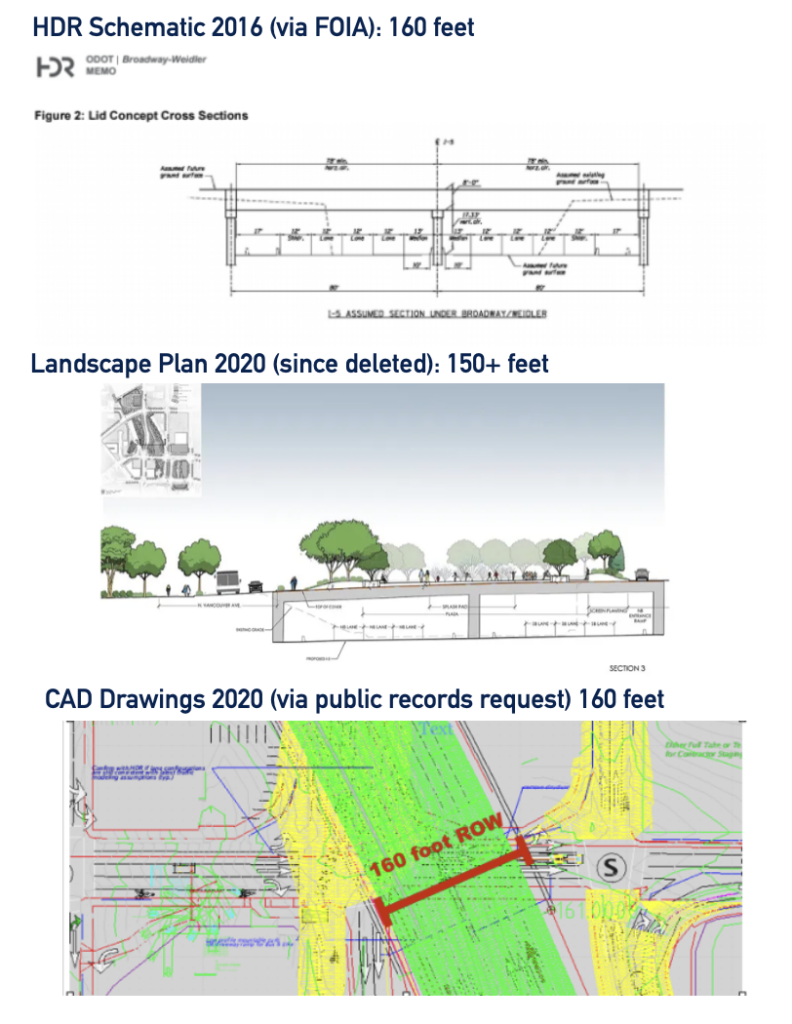The cost of the $1.9 billion Rose Quarter freeway is driven by its excessive width
ODOT is proposing to more than double the width of the I-5 Rose Quarter Freeway through the Albina neighborhood
ODOT could easily stripe the roadway it is building for ten traffic lanes
The high cost of building freeway covers stems from the project’s excessive width
WSDOT plans to cover I-5 in Vancouver for less than $40 million
The fundamental problem with the Rose Quarter project, and the reason why it has blown through its budget is that really a massive freeway widening project. The agency claims its just adding a couple of “auxiliary” lanes, but in reality, its doubling the width of Interstate 5 in a complex urban environment, and its plans for a much wider roadway are the principal reason the project, and its covers, are so expensive.
A too wide freeway.
What no one seems willing to do is ask basic questions about the Rose Quarter. Is the project worth $1.9 billion? Does it even need to be that big and expensive? Isn’t the skyrocketing cost and ODOT’s growing fiscal crisis a signal that we should consider some other options?
The high cost and prodigious cost overruns of the Rose Quarter are directly related to the excessive width of the project, something that ODOT has gone to great lengths to conceal, characterizing the project as merely adding a single auxiliary lane in each direction. In reality, the project would essentially double the width of I-5 through the Rose Quarter, from its current 82-foot width, to 160 feet (and in some places as much as 200 feet).
A brief chronology shows how ODOT staff have repeatedly concealed or obscured the width of the I-5 Rose Quarter project. Their initial 2019 Environmental Assessment presented a misleading and cartoonish freeway-cross section that appeared to show that the freeway would be widened to about 126 feet.
City Observatory challenged these claims about the width of the freeway to the Oregon Transportation Commission in December 2020, and the commission directed the staff to meet with us to discuss the issue. The staff refused to answer any questions during this meeting, and instead later issued a written report obfuscating the actual width of the freeway.
In March 2021, No More Freeways obtained three different internal project documents indicating that the actual width of the roadway would be 160 feet. These included 2015 engineering drawings, as well as architect’s illustrations and computerized CAD files.
As we’ve pointed out at City Observatory, this cross-section could easily accommodate 10 travel lanes, and regardless of ODOT’s labeling, once built, the road could be re-striped in an afternoon.
Even the project’s Supplemental Environmental Assessment, released in November 2022 conceals the actual width of the project. Here is the project’s own plan showing the freeway cross-section. The plan omits measurements, so we’ve added scale markings showing 200 foot widths.

ODOT’s own consultants, the internationally recognized engineering firm ARUP, concluded that the Rose Quarter project was vastly wider than it needed to be. They pointed out that no comparable urban freeway in any city has the over-wide 12 foot shoulders designed into the Rose Quarter project. ARUP concluded that the extreme width of the ODOT design was the principal reason freeway covers cost so much, and said the freeway could be 40 feet narrower than ODOT’s design. ODOT’s own “Cost to Complete” report concedes that a key cost driver is the need to lower the surface of the existing roadway in order to provide the necessary vertical clearance over the much thicker overpass beams that will be needed to span the wider roadway.
Covers alone could be vastly cheaper
If this project consisted simply of building a cover over the existing I-5 freeway, it would be vastly cheaper. Washington’s Department of Transportation is proposing to build a similar cover over a portion of I-5 in Vancouver as part of the Interstate Bridge Replacement Project; The cover, called the “Community Connector” is designed to re-connect historic Fort Vancouver with the city’s downtown. It will be about 300 feet wide, and about an acre in size and is estimated to cost $37 million.
Vancouver’s proposed Community Connector cover I-5 for just $37 million
ODOT has never explored simply building a lid over the existing freeway to “re-connect” the community. If this were simply about building a cover to re-connect the community, it could have been done by now for a fraction of the $115 million ODOT has spent so far, just on planning the Rose Quarter.
What to do instead:
ODOT could cap the I-5 freeway at the Rose Quarter without widening it. And if ODOT is really committed to “restorative justice” reallocate available money for this project as reparations to the Albina community, and allow them to spend it however they see fit to rectify the damage done by the construction of of I-5, Interstate Avenue and the Fremont Bridge ramps. Oregon routinely spends highway funds mitigating the environmental damage of its freeways, on everything from sound walls to wetlands. It also has used highway funds to replace displaced structures (the old Rocky Butte Jail), and other states have used federal highway funds to replace housing destroyed by freeway construction. If we were serious about redressing the harm done to the Albina neighborhood, we’d be looking to reduce the size of I-5, and spend more money improving the neighborhood, and building the housing ODOT destroyed.



